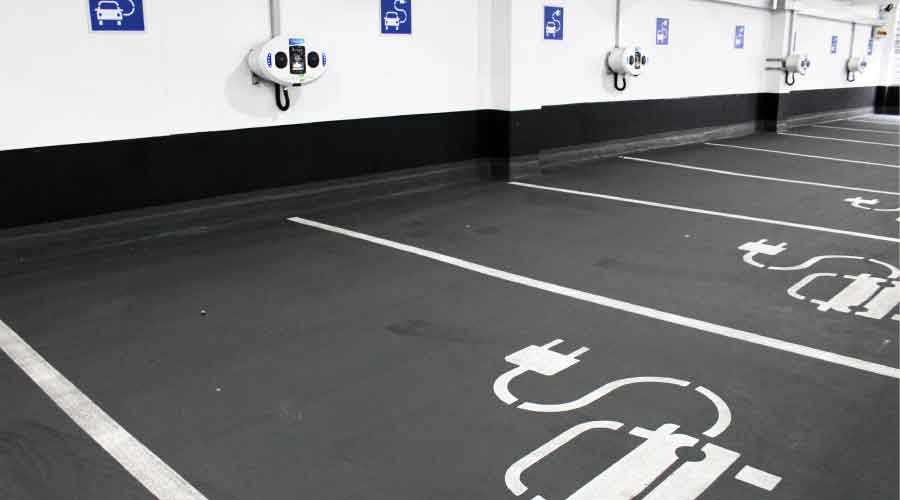How to Prepare Buildings for the Electric Vehicle Boom
With incentives and tax credits available, and tenants increasingly viewing EV charging now is the best the time to investigate installing electric vehicle service equipment (EVSE) in your facility.
By Elbert Walters III, contributing writer
Electric vehicle (EV) sales are on the rise. With a slew of automobile manufacturers, municipal governments, and businesses of all sizes pledging to adopt all-electric fleets in the next decade or less, it’s clear that a new age of automotive travel is upon us. While this is an exciting time, it also leaves questions for those considering updating their commercial properties with electric vehicle service equipment (EVSE).
Is EVSE installation in commercial facilities a smart move for landlords looking to provide sustainable amenities to tenants and workers? If so, how might those installations impact a building owner’s overall energy spend? Does the facility have the infrastructure to support EV charging stations? Perhaps you may even wonder if consumers are really ready to go “all-in” on electric vehicles.
Of course, answers to questions like these are never clear-cut. The EVSE landscape is complex, and only getting more so — which is why it pays to consider the benefits and constraints of installing charging stations now, instead of later.
The current EVSE landscape
Given organizational goals to transition to electric transportation and governmental rebates and incentives making it easier for consumers to purchase EVs, it’s safe to say that an investment in EVSE now will pay dividends later.
The numbers don’t lie: rebates and tax incentives, such as the $7,500 Plug-In Electric Drive Vehicle Credit, or state-specific charging station rebates — which can, in some states, help recoup up to 80 percent of EVSE installation costs — make now an excellent time to begin installing EVSE. With the number of EVs in service projected to outpace gas-powered vehicles by 2033, commercial property owners should act now on deals that will save them considerably down the road.
What’s more, EV charging stations have different benefits, depending on how the organization uses them. For example, perhaps larger businesses might consider offering free charging as a perk for valued customers or employees, whereas small-to-midsize properties may decide to charge visitors and tenants to use charging stations. After the initial investment, overhead will remain low for building managers and the benefits of offering EV charging are great.
While the benefits of EVSE are great, there are some constraints. Though rebates and incentives are making it more cost-effective, EVSE can be costly. Also, some businesses don’t currently have the electrical capacity to add EV chargers, making it more complicated and costly. When installing EVSE or expanding your charging infrastructure, there certainly can be hurdles to overcome, but it’s important to not let these initial complications sway you from making some investment in EVSE now. Though EV chargers might be “nice to have” for businesses and organizations today, they will soon be expected by customers, tenants, and employees alike.
Considerations for EVSE installation
As landlords and business owners move to incorporate EV charging stations into their existing infrastructure, there are a number of important factors to consider. Specifically, a proper EVSE installation plan should include:
- Assessing the overall property layout
- Determining the number of parking spaces and chargers required
- Measuring the distance to an electrical service source
- Making weather infrastructure considerations, including awnings for cooling and cord management to protect from snow plows and ice
- Creating parking and charging accommodations for people with disabilities
- Assessing lighting and security camera needs
- Building for future accommodations and capacity expansions
- Determining equipment requirements needed to facilitate installation, including cranes, trenching, directional boring and more
Clearly, there are many moving parts when it comes to EVSE — which is why these decisions are best left to a specialized electrical contractor equipped to handle EV charging station installations. Once a contractor has conducted a site assessment, commercial facilities owners and their contractors should proceed by putting together a construction budget proposal and installation timeline. A great contractor can help by looking for any and all available grants, rebates and tax incentives that can help offset the capital expenses of EVSE implementation.
Once a proposal is put together, local utilities and government officials will need to be contacted to determine if any permits or supplemental electrical infrastructure are required. After permits have been secured and any auxiliary infrastructure has been installed, the EVSE installation can properly begin.
The final consideration for facility managers adopting EVSE involves developing a plan for charging station maintenance and repair. While modern charging stations are built to withstand up to 10,000 connections, having a contractor at the ready to resolve any issues that arise will be critical to keeping equipment running at peak efficiency. Assigning a contractor to conduct preventive maintenance from vehicular impact, wear and tear and weather exposure should be a part of any EV installation routine.
Ensuring EV charging stations are properly installed
In order to make sure all EVSE installations are performed properly — and are built to prepare for not only long-term use, but also future expansion — it’s critical to hire a reputable and highly-trained contractor. Look for electrical contractors who are specially trained and have up-to-date knowledge of EV charging station installation and maintenance.
For resources on finding a contractor and proper installation, check out the National Electrical Contractors Association’s searchable database. You can also download this EV charger installation e-book.
Many forward-thinking organizations are looking to keep up with the growing popularity of electric vehicles — a promising trend that, in 2022 and beyond, shows no signs of slowing down.
Elbert Walters III is Executive Director of Powering Chicago.
Related Topics:












